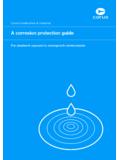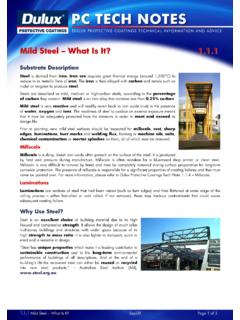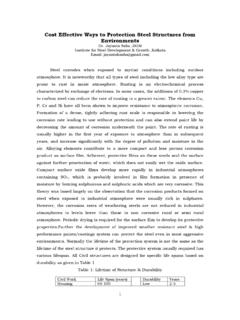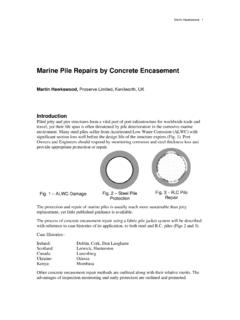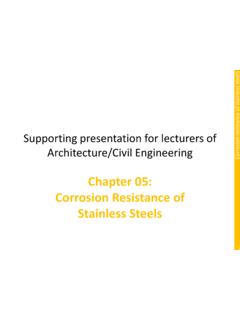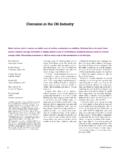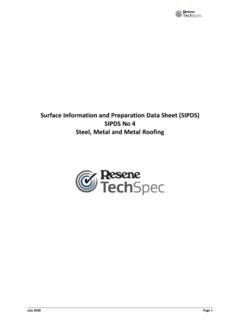Transcription of An Introduction to AS/NZS 2312.2:2014 - Galvanizing
1 An Introduction to AS/NZS :2014 New Zealand Hot Dip Galvanizing StandardsDesign & Durability AS/NZS Guide to the protection of structural steel against atmospheric corrosion by the use of protective coatings Part 2: Hot dip galvanizingManufacturing AS/NZS 4680 Hot-dip galvanized (zinc) coatings on fabricated ferrous | An Introduction to AS/NZS :2014 During the review process, it was recognised that steel designers would benefit by separating it into product specific sections to avoid confusion. The revised Standard was released in December 2014; with Part 1 covering paint systems and Part 2 covering hot dip Galvanizing (HDG). Both new parts use the same definitions from Table 14 of NZS :2009, but now clearly recognise that the design process and durability of the two products are very wishing to specify HDG need only use two Standards; one covering the design and durability of HDG steel ( AS/NZS ), and the other dealing with the manufacturing process and tolerances ( AS/NZS 4680).
2 BackgroundAS/NZS 2312, Guide to the protection of structural steel against atmospheric corrosion by the use of protective coatings, originated in 1967 as a guide for steel designers who needed advice on methods for the corrosion protection of structural steel . The last revision (2002) incorporated much information on the common methods of corrosion protection , including paint, hot dip Galvanizing , thermal spray, powder coating and wrapping systems. Unfortunately the complexity of designing and specifying protective paint systems meant that much of the useful information on hot dip Galvanizing was lost in the detail of the other systems. Improved durability selectionAS/NZS references the latest international corrosivity (ISO 9223/ISO 9224) and design Standards for HDG (ISO 14713). This means that the design durability ( life to first maintenance ) of HDG is now aligned with long term performance results from New Zealand and world recognised Standards.
3 As a result, the estimated life for HDG coatings on structural steel has increased as shown in Table 46802014 versus 2002AS/NZ Corrosivity category & Life to first maintenance (years) steel thickness mmCoating mass & thicknessDesignationg/m2 mC2C3C4C5CX*> to >10026-7813-266-132-6200225+15-255-152-5 --> to >10033-10016-338-162-8200225+25+10-255-1 0--> >10040->10020-4010-203-10200225+25+15-25 5-15-->> HDG9002014>10060->10030-6015-305-1520022 5+25+25+10-25--50C1C2C3C4C5CX45403530252 01510500 20 40 60 80 100 120 140 160 180 200 Coating thickness ( m)Coating life to first maintenance (years)45 m55 m70 m85 m125 mTable 1: Life to first maintenance of hot dip galvanized steel complying to AS/NZS 4680 NOTES: * CX is a new corrosivity category, not previously referenced in local or international Standards.
4 Hot dip galvanized coatings thicker than 85 m are not specified in AS/NZS 4680, however in conjunction with the galvanizer, a specification can be written for thicker 1: With a specified minimum HDG coating thickness of 85 m, AS/NZS can be used to estimate this bridge rail will be protected from rust for over 50 years in a C3 (medium) 2: Calculated corrosivity rates for hot dip Galvanizing from AS/NZS can be restated in a graphical format for quick estimates. For example, a coating thickness of 85 m can be estimated to last a minimum of 20 years to a maximum of 40 years in a C4 Association of New ZealandA single table is provided for designers to compare the expected durability of different galvanized products, including in-line galvanized steel , allowing for a faster product selection durability of a HDG coating is now calculated from the minimum average coating thickness in AS/NZS 4680, which also means non-standard HDG thicknesses can be easily assessed for estimated life to first maintenance.
5 This can be done by using Figure 2, where the macro-environment corrosivity zone can be determined from Table 2: Corrosivity in New Zealand as described in NZS Corrosion map zone & AS/NZS Corrosion categoryTypicallyLocationSeasprayC51 Within 200 metres from breaking surt on the West Coast of the South Island. Within 100 metres from breaking surf on West Coast of the North 50 metres from breaking surf of all other coasts200 metres up to 500 metres or more inland from breaking the immediate vicinity of calm salt water such as harbour foreshoresWest Coast of the South IslandC4150 metres up to 500 metres or more inland from breaking surf. In the immediate vicinity of calm water such as harbour coasts except West Coast of the South Island500 metres to 1km from breaking surf. In the mmediate vicinity of calm salt water such as Coast of the South IslandZone 1C3 East Coast of both Islands, South Coast of North Island & all harboursMore than 1km to 20km from salt and South Coast of South IslandMore than 1km to 5km from salt Coast of both Islands, West Coast of North Island, South Coast of North Island & all 2C2 More than 20km to 50km from salt & South Coast of South than 5km to 50km from salt Coast of both Islands, West & South Coast of North Island, and all 3C2 Inland, more than 50km from salt & South 4C5 Close to the geothermal source < 150mTaupo Volcanic ZoneC2 Not closer than 150m to geothermal : 1.
6 C4 and C5 atmostpheric corrosivity classifications may be extended inland by prevailing winds and local Full details of macro climate and micro-climate atmospheric corrosivity classifications are shown in clause 5 of NZS and P relationshipInitial ppearanceResistance to mechanical damageMass of coatingAHot rolledSi Si+ shinyExcellentStandard; generally superior to the normal requirementCold rolledSi + < Si , can tend to be mottled or dull with increasing steel thicknessGoodAlways heavier than normal; best specification for corrosive < Si be dark and courseReducedExcessively thick coatings may occurDSi > with %SiNew design adviceAS/NZS includes information on how the chemistry of some steels may cause excessively thick coatings. In addition, when initial aesthetic appearance is important, the advice can be used to provide information on the typical coating characteristics, as described in Table 3: The effect of silicon and phosphorus on hot dip galvanized coating characteristics 3 | An Introduction to AS/NZS :2014 Painting over hot dip Galvanizing (duplex coating)An all new and detailed section on the design of duplex coatings (paint over HDG) is included, with two performance options for durability (aesthetic and corrosion).
7 A duplex system will increase the service life of the HDG article beyond that of the unpainted article. Further, the total life of a properly specified, applied and maintained duplex coating system is significantly greater than the sum of the lives of the HDG coating and the paint coating alone (by times, depending on the environment). AS/NZS includes seven decorative and industrial paint systems suitable for most corrosivity 3: The Moment by Damian Vick, showing the four key stages of fabrication, Galvanizing , painting and the final structure in place. This aesthetic sculpture is an example of a complex shape with sharp edges and is therefore suited to a duplex and fabrication design detailsAppendices to the Standard also cover corrosion in different environments, including bimetallic corrosion and the interaction of HDG steel with soil, concrete, water, chemicals, and engineers and fabricators, the design details are extensive and pictorial advice on good design practice provides clear instruction, such as the examples shown in Figure 4.
8 The effect the fabricated article s condition has on the HDG process, for example the size of the article, laser cutting and other thermal processes, and required tolerances, are clearly 4: : Illustrations in Appendix A of AS/NZS allow the designer to improve zinc flow in the process, which will improve the aesthetics of the finished product, reduce the cost & eliminate danger to the Galvanizing plant new AS/NZS allows designers to more accurately estimate the durability of HDG coatings. In addition, the Standard provides detailed design advice for duplex coatings. It details how the steel chemistry can affect the HDG coating and also illustrates good design practice. It will serve as an essential aid for engineers, architects, specifiers and consultants for many years to can be purchased from SAI Global ( ) or Standards New Zealand ( ).
9 More information and free training on the use of AS/NZS and hot dip Galvanizing in general is available from the Galvanizing Association of New Zealand ( ).
